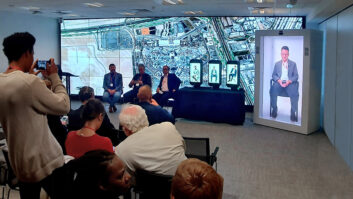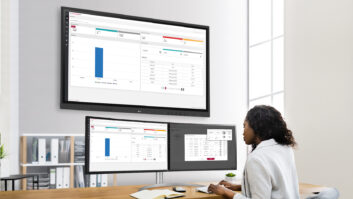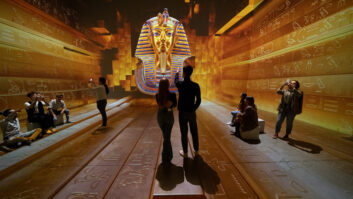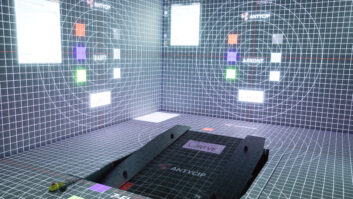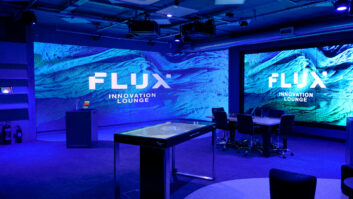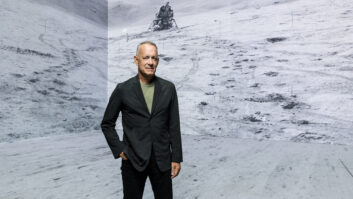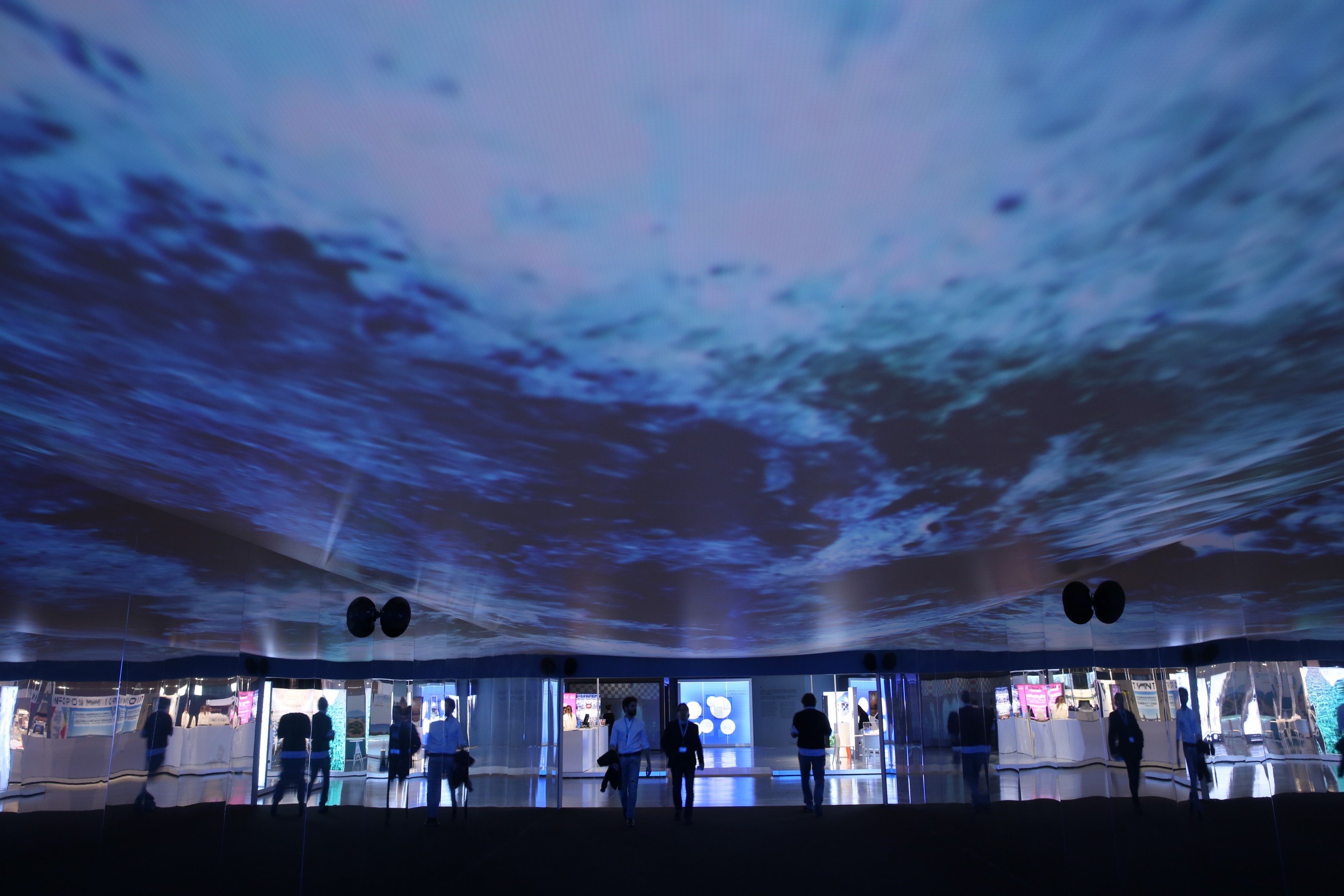
Multimedia technology is helping to open up the debate around the importance of water, the environment and climate change, writes Mike Clark.
Organised under the patronage of Expo 2015, Aquae Venice 2015 is a universal exhibition running from May to October, alongside the Milan event. Dedicated to water, its aim is to describe, in a simple, experiential and educational manner, how and why water influences our lives through a series screenings, discussions, interactive displays and multi-sensory experiences. UNESCO’s World Water Assessment Programme, dedicated to the study of global issues related to water, is an Aquae partner.
The new multipurpose 107,640sqft building hosting the event was designed by architect Michele De Lucchi, also responsible for Pavilion Zero at the Milan Expo, and at the end of Aquae Venezia 2015 it will become Venice’s new expo and trade fair hub.
Interiors were designed by the Gris Dainese under the artistic direction of Davide Rampello (TV and theatre director and cultural & management consultant for national and international institutions); the AV systems were designed and installed by Show Live Srl.
Visitors’ first impact with the main multimedia systems is in the entrance tunnel as they walk under a virtual cool bubbling mountain stream running over their heads that accompanies them towards the main expo area. Other areas are a large projection surface in the restaurant zone, a huge central dodecahedron (with video on all 12 sides) and the high-impact immersive 360º Journey into the Abysses.
Show Live’s account manager for northern Italy, Matteo Boro, explains: “The main difficulties faced on this project included the short time frame between confirmation, definition of the executive design and move-in, and the fact that we had to work simultaneously with the teams responsible for set-up and stand-fitting for the exhibitors, so we had to be careful to avoid our staff’s work overlapping.”
In the entrance tunnel, a pair of Christie Roadster HD20K-J projectors with 0.67 lenses flown from the pavilion’s ceiling were used for rear projection on the 120sqm roof, made from Peroni Nevada milky white PVC rear projection film. Sound in the tunnel was played back via six Electro-Voice EVID enclosures powered by an Audiocenter VA-401 Class H power amp and four Work Pro NEO S8A self-powered subwoofers.
Shaping up
For the dodecahedron, the 12 19ft x 29ft sides were covered by 24 Christie Roadster HD20K-J projectors with 1.1 lenses, flown in (stacked) pairs from the roof.
To support this original screen, made with three sections of Peroni Blackout PVC front projection film, each measuring 82ft x 28ft, the structure’s framework was built with triangular trussing by Litec Italia, chosen for its combination of weight and structural resistance to the traction due to the screen’s dimensions. Over 820ft of TX30 SA trussing and 24 custom three-way corner junctions are used.
A hook-and-loop system was used to connect the three sections of screen, enabling their tension to be adjusted during installation, thus ensuring a smooth continuous projection surface, also bearing in mind the variation in temperature, to which PVC is particularly sensitive.
The flown dodecahedron was a first for both Litec and Peroni and features audiovisual clips on water and its relationship with food, climate, technology and religion.
The dramatic Journey into the Abysses spectacle features a 13ft-high circular screen with a diameter of almost 60ft. The total front projection area (2,420sqft) is covered by eight Christie HD9K-J three-chip DLP digital projectors with 0.67 lenses mounted on a truss ring in the centre. Here audio is courtesy of a quartet of Electro-Voice ZLX15P enclosures.
Restaurant
The 3,100sqft projection surface in the restaurant area (in this case the pavilion wall was used) is covered by two Christie Roadie HD+30K DLP digital projectors with 1.25/1.45 lenses. Here, the Audiocenter sound reinforcement system comprises eight K-LA28 line array enclosures, powered by two VA-801 Class H amps, plus a pair of self-powered TS-SW118 subwoofers (1 x 18in, 1,200W) with DSP. Handheld and headset EV microphones and other sound sources at the various events staged in the venue are mixed on a Yamaha MG16XU 16-channel console.
Four Dataton Watchout units were deployed for the projections, with 18 of their 24 outputs used.
The Show Live team designed and built the screens, as well as installing them and the relevant AV hardware. The 360º immersive installation and the dodecahedron both ensure high-impact results but, in spite of the impressive amount of hardware they involved, the physical installation and the planning at drawing board stage were the most demanding aspects, as technical manager Claudio Renzetti explains: “We had to install all the aerial cable runs, as they were non-existent in the building – this involved a total of over 4.5 miles of fibre, Cat5 and mains power cable and a week’s work.”
As far as the actual projectors were concerned, the suspension of the dodecahedron’s 24 projectors at a height of 15m had to be studied carefully, taking into consideration the risk of movement due to the conditioning system’s air currents, overcome by fixing four suitable inclined steel cables to the roof girders for each pair.
Video content was produced by Padua specialists Drawlight, whose customer and project manager Alberto Gentilin explains: “As well as the content for the 104ft curved screen in the restaurant area, which was video footage dedicated to food, we produced a projection mapping project for the enormous 9m-high dodecahedron in the centre of the pavilion, which covers the 12 faces with synchronised video content supplied by artists and associations connected in various ways with water, such as the cross-Adriatic swim, etc. There are also infographics dedicated to the world of water which consist in our 2D and 3D animations of figures regarding water, pollution, the evolution of the sea, fishing, marine species, and so on, in the coming years”
However, Drawlight’s production team’s biggest challenge was to entirely rethink in 3D a descent into the abysses that would enable visitors to explore this mysterious world. The original video animation, produced in the Padua studios entirely in 3D, takes visitors down into the depths, meeting countless ocean creatures.
“We created an immersive 360º projection simulating a descent into the oceanic abysses. One of the pavilion’s main attractions, the installation is positioned in the very heart of the building, at the centre of the futuristic dodecahedral structure. The unique spectacle is screened every 15 minutes, and all the animations are the result of in-depth research, with the help of expert oceanographers, on the various species that inhabit the ocean depths. Thanks to the project’s combination of science and entertainment, visitors are treated to an exciting, high-impact experience.”
The video’s idea and direction was by Davide Rampello and the six-strong production team (a combination of Drawlight staffers and freelance specialists who work regularly with the studio) comprised Alberto Gentilin and Luigi Dalla Riva (art directors), Rudy Bertazzo (motion graphics), Nello Fontani and Simone Nastasi (3D artists and animation) and Edoardo Piccolo (music for the original soundtrack).
Gentilin concludes: ”The spectacle ensures visitors enjoy an experience that is not only extremely exciting, but also educational!”
www.ac-pro.net
www.aquae2015.org
www.christiedigital.com
www.dataton.com
www.drawlight.net
www.electrovoice.com
www.grisdainese.it
www.litectruss.com
www.peroni.com
www.showlivesrl.com
www.workproaudio.com
www.yamahaproaudio.com

